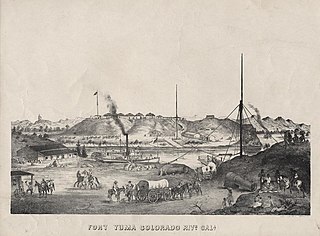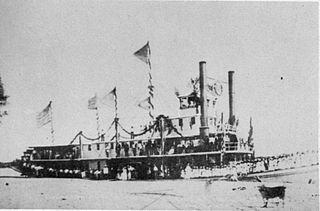
Cochan, (Quechan) last of the stern-wheel steamboats built for the Colorado Steam Navigation Company (CSNC). It ran on the Colorado River between 1900 and 1909.

Cochan, (Quechan) last of the stern-wheel steamboats built for the Colorado Steam Navigation Company (CSNC). It ran on the Colorado River between 1900 and 1909.
In 1899 Issac Polhamus and Jack Mellon owners of the CSNC had to choose one of their remaining steamboats to rebuild to keep up with the competition. The old boats were wearing out in competition with newer boats. Both the 23-year-old Mohave II and the Gila, with 35 years on the Colorado River, had worn hulls only kept going with a lot of maintenance. The Gila despite its age had better engines, and so it was chosen.
In late 1899 the Gila's machinery was refurbished and its hull rebuilt for $25,000 in the shipyard at Yuma, Arizona. Launched on November 8, 1899, it was renamed the Cochan it was two tons lighter and 14 feet shorter than the Gila. Cochan displaced 234 tons, was 135 feet long, 31 feet wide beam, and drew only 11 inches of water unloaded. It could carry 125 tons of freight, drawing less than two feet of water.
In January 1900, the Cochan began carrying freight to the Quartette and Searchlight mines, competing with the St. Vallier of the Santa Ana Mining Company. In 1900, Polhamus and Mellon built a new barge, the Siløs J. Lenis for the Cochan to tow and scrapped all their old barges. The new barge was 150 feet long and 32 feet on the beam. In early 1903, the Colorado River Transportation Company entered the competition with the Searchlight. [2] : 91, 95
In 1905 the new Los Angeles and Salt Lake Railroad, California Eastern Railway and Arizona and California Railroad ended the use of steamboats on the upper river and they all moved down to Yuma. The remaining steamboats worked on irrigation projects on the lower part of the river and on repairing the 1904-1907 breach in the Alamo Canal, that directed the Colorado River into the Salton Sink and created the Salton Sea before it was repaired. The last project, the construction of the Laguna Dam ended steam navigation on the river. [2] : 135–160
Just before the completion of the Laguna Dam, some 14 miles above Yuma, ended steam navigation on the lower Colorado River, the Colorado Steam Navigation Company sold its remaining boats including the Cochan to the United States Reclamation Service in 1909. Not required by the Service, Cochan was dismantled in 1910. [2] : 156–159

Wide West was a steamboat that served in the Pacific Northwest of the United States. It had a reputation as a luxury boat of its days.

Many steamboats operated on the Columbia River and its tributaries, in the Pacific Northwest region of North America, from about 1850 to 1981. Major tributaries of the Columbia that formed steamboat routes included the Willamette and Snake rivers. Navigation was impractical between the Snake River and the Canada–US border, due to several rapids, but steamboats also operated along the Wenatchee Reach of the Columbia, in northern Washington, and on the Arrow Lakes of southern British Columbia.

Port Isabel was a seaport established on Port Isabel Slough in 1865 during the American Civil War in Sonora, Mexico in the mouth of the Colorado River on the Gulf of California. It was founded to support the increased river traffic caused by the gold rush that began in 1862 on the Colorado River and the Yuma Quartermaster Depot newly established in 1864 to support the Army posts in the Arizona Military District. The slough was discovered in 1865 by the Captain W. H. Pierson of the schooner Isabel, that first used the slough to transfer its cargo to steamboats safe from the tidal bore of the Colorado River. Shortly afterward Port Isabel was established 3 miles up the slough and replaced Robinson's Landing as the place where cargo was unloaded in the river from seagoing craft on to flat bottomed steamboats of the Colorado River and carried up to Fort Yuma and points further north on the river.
George Alonzo Johnson (1824–1903) was an American entrepreneur and politician.

Steamboats on the Colorado River operated from the river mouth at the Colorado River Delta on the Gulf of California in Mexico, up to the Virgin River on the Lower Colorado River Valley in the Southwestern United States from 1852 until 1909, when the construction of the Laguna Dam was completed. The shallow draft paddle steamers were found to be the most economical way to ship goods between the Pacific Ocean ports and settlements and mines along the lower river, putting in at landings in Sonora state, Baja California Territory, California state, Arizona Territory, New Mexico Territory, and Nevada state. They remained the primary means of transportation of freight until the advent of the more economical railroads began cutting away at their business from 1878 when the first line entered Arizona Territory.
David C. Robinson, was a steamboat captain on the Colorado River from 1857 to 1873.
Colorado, was a stern-wheel paddle-steamer, the third steamboat on the Colorado River, and first stern-wheel steamboat put on that river, in December 1855.
General Jesup was a side-wheel paddle-steamer, named for General Thomas Jesup then Quartermaster General of the United States Army, and was the second steamboat launched on the Colorado River, in 1854.

Cocopah II, was a stern-wheel paddle-steamer, the tenth steamboat on the Colorado River, first put on the river in 1867.

Colorado, second of its name on the Colorado River, was a stern-wheel paddle-steamer, rebuilt from the original Colorado was the fifth steamboat on the Colorado River. It was first put on the river in December 1862.
Esmerelda, was a stern-wheel paddle-steamer, built for the Sacramento River trade, in 1864 it became the first of the opposition steamboats on the Colorado River. It was also the first steamboat to tow large cargo barges on that river, in May 1864 and to reach Callville, Nevada in 1866.

Benjamin Minturn Hartshorne was an American businessman rose to prominence during the California Gold Rush. He was involved in Sacramento River and Colorado River steamboats as well as maritime shipping.
Mohave was the first stern-wheel steamboat of that name running on the Colorado River between 1864 and 1875.

Emma Hayward commonly called the Hayward, was a steamboat that served in the Pacific Northwest. This vessel was once one of the finest and fastest steamboats on the Columbia River and Puget Sound. As newer vessels came into service, Emma Hayward was relegated to secondary roles, and, by 1891, was converted into a Columbia river tow boat.
Nina Tilden, one of the two opposition stern-wheel steamboats that ran on the Colorado River from 1864 to 1868. Purchased by George A. Johnson Company it ran on the Colorado River from 1868 until 1874.
Gila, a stern-wheel steamboat of the Colorado Steam Navigation Company running on the Colorado River between 1873 and 1899.
George A. Johnson & Company was a partnership between three men who pioneered navigation on the Colorado River. Benjamin M. Hartshorne, George Alonzo Johnson and Alfred H. Wilcox. The George A. Johnson & Company was formed in the fall of 1852, and was reorganized as the Colorado Steam Navigation Company in 1869.

Mohave, the second stern-wheel steamboat of that name running on the Colorado River for the Colorado Steam Navigation Company (C.S.N.C) between 1875 and 1876. It was the first and only double smokestack steamboat to run on the river.
Quartette or Quartette Mill or Quartette Landing, was a mining settlement, location of the stamp mill of the Quartette Mining Company, owner of the largest mine in the Searchlight Mining District and a steamboat landing on the Colorado River, in what is now Clark County, Nevada. It lay at an elevation of 646 feet.

Steam navigation on Lake Coeur d'Alene lasted from the 1880s to the 1930s. More steamboats operated on Lake Coeur d’Alene than on any other lake west of the Great Lakes. The high point of steam navigation was probably from 1908 to 1913. After that railroads, and increasingly automobile and truck traffic on newly built highways supplanted steam navigation, although some vessels continued to be operated until the mid-1930s.